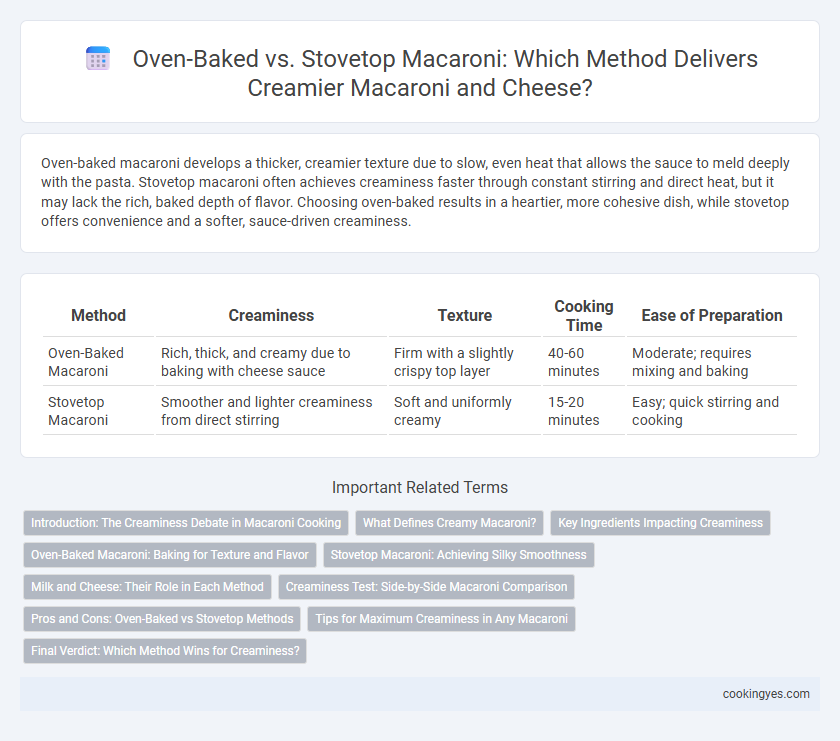Oven-baked macaroni develops a thicker, creamier texture due to slow, even heat that allows the sauce to meld deeply with the pasta. Stovetop macaroni often achieves creaminess faster through constant stirring and direct heat, but it may lack the rich, baked depth of flavor. Choosing oven-baked results in a heartier, more cohesive dish, while stovetop offers convenience and a softer, sauce-driven creaminess.
Table of Comparison
| Method | Creaminess | Texture | Cooking Time | Ease of Preparation |
|---|---|---|---|---|
| Oven-Baked Macaroni | Rich, thick, and creamy due to baking with cheese sauce | Firm with a slightly crispy top layer | 40-60 minutes | Moderate; requires mixing and baking |
| Stovetop Macaroni | Smoother and lighter creaminess from direct stirring | Soft and uniformly creamy | 15-20 minutes | Easy; quick stirring and cooking |
Introduction: The Creaminess Debate in Macaroni Cooking
Oven-baked macaroni often delivers a thicker, more uniformly creamy texture due to slow, even heat distribution that allows cheeses and sauces to meld and thicken without breaking. Stovetop macaroni typically achieves creaminess faster through continuous stirring, which helps prevent curdling and ensures a smoother sauce consistency. The choice between methods depends on desired texture: oven-baked excels in rich, cohesive creaminess while stovetop offers quicker, silky results.
What Defines Creamy Macaroni?
Creamy macaroni is defined by the smooth, rich texture of the cheese sauce that thoroughly coats each pasta piece without separating or becoming grainy. Oven-baked macaroni often results in a thicker, more custard-like creaminess due to the prolonged, even heat that allows cheese and milk to meld and thicken uniformly. Stovetop macaroni delivers a silkier, lighter creaminess by retaining more moisture and preventing the sauce from drying out, preserving the creamy consistency throughout the dish.
Key Ingredients Impacting Creaminess
Oven-baked macaroni often achieves creaminess through the incorporation of cheese sauces that thicken and meld during baking, with key ingredients like whole milk, heavy cream, and a roux made from butter and flour enhancing texture. Stovetop macaroni relies on constant stirring and gradual addition of dairy ingredients such as evaporated milk, cream cheese, or Velveeta to maintain a silky, smooth consistency. The choice and balance of dairy fats, starches, and melting cheeses directly impact the creamy mouthfeel in both cooking methods.
Oven-Baked Macaroni: Baking for Texture and Flavor
Oven-baked macaroni develops a richer, creamier texture as the heat evenly melts cheese and thickens the sauce during baking, creating a luscious, cohesive dish. The baking process allows moisture to evaporate slowly, concentrating flavors and producing a slightly crispy, golden crust that enhances taste and mouthfeel. This method yields a more indulgent and flavorful macaroni experience compared to stovetop preparation.
Stovetop Macaroni: Achieving Silky Smoothness
Stovetop macaroni offers superior control over heat and stirring, allowing the pasta to cook evenly and absorb the creamy sauce thoroughly, resulting in a silky smooth texture. Constant gentle stirring prevents clumping and ensures the cheese sauce emulsifies perfectly, creating a rich, velvety consistency. This method enhances flavor integration, making stovetop macaroni ideal for achieving an irresistibly creamy dish.
Milk and Cheese: Their Role in Each Method
Oven-baked macaroni relies on gradual heat that allows milk and cheese to melt and thicken evenly, creating a rich, creamy texture with a golden, bubbly crust. Stovetop macaroni uses direct heat, which requires constant stirring to prevent milk from curdling and cheese from separating, often resulting in a smoother but less firm creaminess. The slow baking process enhances cheese's flavor development and milk's thickening through evaporation, while stovetop cooking retains more moisture and a softer consistency.
Creaminess Test: Side-by-Side Macaroni Comparison
Oven-baked macaroni often results in a firmer texture with a slightly drier surface, which can reduce overall creaminess compared to stovetop macaroni. Stovetop macaroni maintains a consistent, creamy sauce by allowing better moisture retention and quicker heat distribution, enhancing the silky texture of the cheese sauce. In a side-by-side creaminess test, stovetop macaroni consistently ranks higher for smoothness and rich mouthfeel, while oven-baked versions excel in a baked, crispy topping but sacrifice some creamy consistency.
Pros and Cons: Oven-Baked vs Stovetop Methods
Oven-baked macaroni offers a richer, creamier texture due to slow, even heat that allows cheese to melt and thicken uniformly, but it can sometimes dry out if not carefully monitored. Stovetop macaroni provides a quicker method, maintaining a smooth and creamy consistency by stirring constantly, though it risks becoming watery or clumpy if the balance of liquid and heat is off. Choosing between these methods depends on desired texture, cooking time, and attention level, with oven-baked favored for depth of flavor and stovetop ideal for speed and control.
Tips for Maximum Creaminess in Any Macaroni
For maximum creaminess in oven-baked macaroni, use a combination of sharp cheddar and whole milk, baking at 350degF until bubbling to allow even melting and thickening. In stovetop macaroni, gradually stir in warm cream cheese and a splash of pasta water to create a smooth, velvety sauce that clings perfectly to the noodles. Whichever method, avoid overcooking pasta and stir gently to maintain the creamy texture without breaking down the macaroni.
Final Verdict: Which Method Wins for Creaminess?
Oven-baked macaroni tends to have a thicker, more cohesive texture due to the extended baking time allowing cheese sauces to meld and thicken, resulting in a rich creaminess. Stovetop macaroni offers a lighter, silkier creaminess as the sauce remains more fluid and less concentrated, preserving a smoother mouthfeel. For maximum creaminess, oven-baked macaroni wins by creating a dense, velvety sauce that clings well to the pasta.
Oven-Baked Macaroni vs Stovetop Macaroni for Creaminess Infographic

 cookingyes.com
cookingyes.com